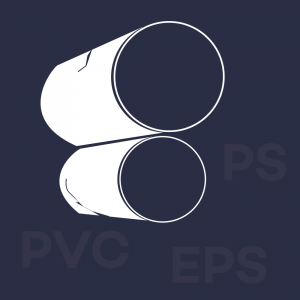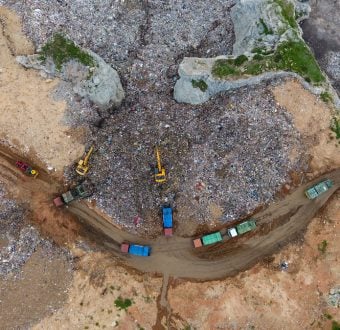This article is the first of six in our series, Going Plastic Free, to share how we can tackle the plastic pollution crisis by building a Zero Waste future with refuse, reduce and reuse businesses that reimagine the way we deliver, consume and pack products. Tune in next Thursday for the second installment, Zero Waste is the New Normal.
This first piece we’re going to dive into the big picture:
- Why plastic pollution is such a big problem.
- Why we need to reduce plastic production — and how much plastic packaging corporations use for products — to overcome pollution.
- How recycling cannot stop plastic pollution.
- How upcycling materials and waste-to-energy systems might can cause worse pollution
- How a true zero waste circular economy is what we need to solve the plastic pollution crisis
Here’s the thing, recycling, upcycling and waste-to-energy are means to immediately deal with the amounts of plastic waste that already pile up – they are mopping technologies, but they are not reducing the inflow of plastics into our communities (and eventually the ocean).
Plastic Pollution Facts: Why We Must Bend the Curve of Plastic Production for Our Communities and Ocean
“Recycling is better than disposal, reuse is better than recycling, but reduction is best of all. It is easier to deal with a flood by turning it off at its source than by inventing better mopping technologies.” – Donella Meadows

Plastic packaging production is predicted to quadruple by 2050 and the plastics peak only to be hit by 2100. © Zero Waste Living Lab by enviu.
Predictions clearly call for reduction of plastics at the beginning of the value chain by skipping single-use plastics in the first place. Today only 2% of plastic packaging is recycled closed-loop. Even in a best-case scenario where 53% of plastics are recycled closed-loop (which would half the need for virgin plastic packaging material) plastic production still doubles by 2050. Recycling only slows down the growth rate. With plastic packaging estimated in having a major share of plastics leakage into the ocean, we clearly see that recycling is important, but not closing the tap of plastic pollution.
The planet is already strained from the impacts of today’s plastic, and we are on a path to more than quadruple quantities by 2050. The Plastic Soup Foundation predicts an even worse outlook: we might not reach the “plastic peak”, the moment when the curve will be bend, until 2100.
In more detail: since 1950, we have seen a twentyfold increase in plastic production, of which 75% are categorized as plastic waste today. As plastics do not biodegrade but only “break down into smaller pieces”, 79% of this plastic waste piles up in landfills or the natural environment. With this trend expected to exponentially grow in the next years, By 2050, there will be 12 billion tonnes of plastic waste in natural environments.
Plastic free systems and reducing plastics at the source instead of inventing better plastic pollution mopping technologies
Recycling, upcycling and waste-to-energy conversion are often discussed as a circular opportunity to solve our plastics crisis. Even though recycling is an essential part of a circular plastics economy and efforts should continue, it is not addressing the root cause of the issue.
As we will see, recycling will be insufficient and too late to tackle the exponential growth of plastic packaging production. And upcycling and waste-to-energy conversion even lead to many additional negative externalities. While these end-of-life scenarios form a highly convenient argument for resin producers, packaging producers and fast-moving consumer goods companies to continue to flood the market with single-use plastic, it is actually distracting us from finding more systemic solutions to tackle plastic pollution.
Instead, we need to start by bending the curve of plastic packaging production – tackling the problem at the beginning of the value chain. Introducing business models that reimagine consumption and delivery models that have the potential to actually decrease the growth of plastic pollution. And simultaneously, new business opportunities loom on the horizon – especially as governments around the world are increasing legislation to ban single-use and disposable plastics.
Innovation in this field, for example, refill and reusable subscription models, could strengthen loyalty relationships with consumers, as well as increase value chain efficiencies, reducing costs and negative externalities. Inevitably an opportunity for existing market players to lead the change, ensuring business continuity within a circular economy. And as some pioneering start-ups are showing, there is a growing zero waste customer basis to tap into.
For example, in New Zealand the trend of nude shopping (shopping vegetables and fruits without plastic packaging) proves to be a business case where supermarkets that ditched plastics reported a 300% increase of vegetable sales. Moreover, successful start-ups such as CupClub (to-go-cup as a service), Algramo (refill vending machines) and Repack (reusable e-commerce system) show that skipping single-use plastics opens up a whole new sphere to completely innovating and redesigning today’s shopping experience.
Let us explore in more detail why current mopping technologies of recycling, upcycling and waste-to-energy show limitations to deal with the plastics crisis.
Recycling will not close the tap on plastic pollution
The promise of recycling in which all materials are reused again and again without any leakage to the environment, following the circular economy paradigm, is a misleading notion to stop plastic pollution. Because a realistic assessment shows, we are galaxies away from a perfect circular future.

Graph: Current recycling figures are extremely low with little improvement in the future. Recycling rates are by no means keeping up with the massive amount of plastic packaging produced. Based on Ellen MacArthur Foundation © Zero Waste Living Lab by enviu.
Looking at the projections on global plastic packaging production in relation to global plastic packaging recycling rates, a massive gap between both reveals itself. In 2013, about 14% of plastic packaging globally was collected for recycling of which 4% was lost during the process, 8% was downcycled into lower value material and only 2% was recycled in a closed loop.
Some research even argues that global plastic packaging recycling rates will only amount to around 53% by 2050, in the best-case scenario with best available technology. Fact is, there are significant challenges on the pathway to increase global recycling rates to an extent that we are no longer seeing leakage into the ocean, as we will explore next.
Fact: Recycling is not an option for at least 50% of plastic packaging items.
Small format, multi-material, uncommon and nutrient-contaminated packaging are often highly functional to package goods, but currently lack a viable reuse or recycling opportunity.
In more detail, the problematic nature of plastic packaging that need fundamental redesign and innovation:
Small-format plastic packaging

Sachets, tear-offs, lids, straw packages, sweet wrappers and small pots, tend to escape collection or sorting systems and have no economic reuse or recycling pathway.
Multi-material plastic packaging

Pouches, snack packaging with different plastic and aluminum layers cannot be economically, and often not even technically, recycled currently.
Uncommon plastic packaging material

PVC, PS, and EPS are often technically recyclable, but not economically viable to sort and recycle because their small volumes prevent effective economies of scale.
Nutrient- contaminated plastic packaging

Coffee capsules or fast food packaging are often difficult to sort and clean to be able to enter high-quality recycling.
Following the New Plastics Economy report, these four categories represent at least 50% of plastic packaging (by number of items) and they are unlikely to have a proper reuse or recycling pathway at scale in the foreseeable future.
A True Circular Economy Material Flow for Plastic Packaging is Challenging
Recycling might only replace a part of the virgin feedstock for plastic packaging production, through so called closed-loop recycling. Only for some high quality materials, like PET, (chemical) recycling technologies are available that recycle back in virgin quality feedstock.
However, the majority of plastics will see a decrease in polymer quality and can usually only be recycled about 2-3 times before its quality decreases to the point where it no longer can be used in a circular manner. Even if recycled materials would feedback into the packaging industry, it has to compete with cheap price of virgin plastic – a battle which is currently lost.
Recycling pioneers struggle, waste management newcomers such as Indonesia face a massive gap
Recycling pioneers such as Germany struggle to recycle effectively and efficiently, despite 30 years of experience in the dual system, Germany is currently managing to feedback a mere 28,6% of its plastics waste back into new products in 2017.
Upcoming economies such as Indonesia often lack even the basic collection and waste management systems, with an estimate of 3.2 MMT of mismanaged plastic waste per year. It is highly unlikely that the current fragmented collection and waste management can be built up towards the required infrastructure in time to deal with the exponential tsunami of plastic coming their way.
Upcycling plastic is still a linear process (in many cases) and still causes plastic pollution

Recycling of plastic also can lead to negative effects, such as in the case of upcycling packaging waste to other industries. Certainly, favoring the reuse of materials instead of virgin materials is preferable. However, in many cases, upcycling plastics waste only moves the plastics problem to another sector, namely the fashion industry.
One single polyester fleece jacket release almost one million fibers per washing – which end up in the ocean and ultimately our food chain. Patagonia has upcycled soda bottles into fleece since 1993, and G-Star has replaced conventional polyester in their denims with recycled ocean plastics. Also upcycling for other applications such as housing or tiles often is just another form of extending the linear life with one lifecycle – not a circular model.
Waste-to-energy is no form of recycling and harms the circular economy

Waste-to-energy is considered harmful in respect to its externalities such as toxic emissions, Co2 emissions and toxic ashes. Additionally, only one fifth of calories in these materials are captured when converting plastic waste to energy. © Zero Waste Living Lab by enviu.
Converting waste to energy, by many seen as a form of recycling and an effective solution to reduce pollution, means waste is burned in order to recover energy from it. Aside from the various negative toxic effects through emissions and toxic ash for humans and planet alike, about 90% of burned waste could actually be composted or recycled.
Following the research of Zero Waste Europe, burning these resources to create energy instead of recovering them “discourages efforts to preserve resources and creates incentives to generate more waste.” And in fact, countries such as Denmark have shown that waste burning leads to dropping recycling rates and along with that reduces employment opportunities.
“‘Waste-to-energy’ is often described as a good way to extract energy from resources, but in fact it works against the circular economy, producing toxic waste, air pollution and contributing to climate change – all without delivering what it promised.” -Zero Waste Europe, 2018
A Zero Waste Circular Economy: Towards a New Paradigm for Plastic Solutions
Recycling, upcycling and waste-to-energy are mopping up technologies that will not provide the solution to the exponentially growing plastic pollution problem. The place where we need to start is to fundamentally rethink the way we consume so we can radically reduce absolute volumes of plastics put on the market.
If we really want to bend the curve, we have to innovate and scale business models that reduce plastics at the source. Only then will we be able to sustainably and fundamentality change the course of this problem.


